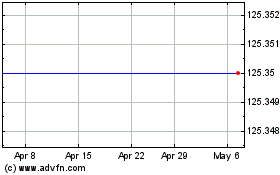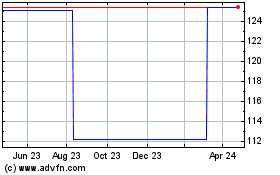Rio Tinto Annual Iron Ore, Aluminum Output Rises -- Update
16 January 2024 - 9:35AM
Dow Jones News
By Rhiannon Hoyle
Rio Tinto on Tuesday said it produced more iron ore, aluminum
and copper last year than the year before, reaching annual targets
as it ramped up new mining operations in Australia and
Mongolia.
The world's second-biggest miner by market value said it
produced 331.5 million metric tons of iron ore at its network of
mines in Australia in 2023, up 2% versus 2022, and shipped 331.8
million tons, up 3%. Rio Tinto, a top exporter of the steel
ingredient, previously told investors it expected shipments in the
upper half of a 320-million to 335-million ton range.
The miner, a large supplier of industrial commodities aluminum
and copper, said it produced more of those metals, too.
Rio Tinto reported annual aluminum production of roughly 3.3
million tons, up 9% year-on-year and at the top end of its own
forecast of 3.1 million to 3.3 million tons. The result was
bolstered by the return to full production at its Kitimat smelter
in Canada.
The company's output of mined copper totaled 620,000 tons. That
was 2% higher than in 2022, before the miner bought out minority
shareholders in the company that controlled the big Oyu Tolgoi
copper-and-gold mine in Mongolia. It had told investors to expect
production between 590,000 and 640,000 tons.
Overall, Rio Tinto said 2023 group output was just over 3%
higher than the year earlier, on a copper-equivalent basis. The
company produces other commodities including diamonds and titanium
dioxide, a white pigment used in paints, plastics and paper. Its
majority owned Dampier Salt joint venture recently penned a $251
million deal to sell the Lake MacLeod salt and gypsum operation in
Western Australia to closely held Leichhardt Industrials Group, Rio
Tinto said.
The Anglo-Australian miner is seeking to fortify its lucrative
iron-ore business by adding operations in Australia's Pilbara, the
world's largest iron-ore producing region, and investing in a giant
mining project in Guinea's Simandou mountains, where the world's
largest known high-grade iron-ore deposit is buried.
Last year, Rio Tinto ramped up production from the high-tech
Gudai-Darri mine, its first brand-new mine in the Pilbara in more
than a decade. In December, it approved a new study for the Rhodes
Ridge project, which it says is the best undeveloped project in the
Pilbara.
The miner is aiming for a medium-term annual capacity of between
345 million and 360 million tons in its iron-ore business in
Australia, a country that accounts for almost three in every five
tons of exports globally.
The miner is also seeking to expand its copper business,
reflected in the takeover of Oyu Tolgoi majority owner Turquoise
Hill Resources that occurred in December 2022. Rio Tinto expects
the Oyu Tolgoi operation in Mongolia's Gobi desert, where it is
ramping up a new underground project, will be the fourth-largest
copper mine in the world by 2030.
Like many of its peers, Rio Tinto is betting that copper will be
in high demand for use in electric vehicles and renewable energy as
the energy transition accelerates.
Rio Tinto said its output of refined copper was lower last year
than the year before, as it completed a $300-million rebuild of the
Kennecott smelter near Salt Lake City, Utah, aimed at strengthening
the company's supply of copper in the U.S. Full-year refined copper
production fell by 16% to 175,000 tons, in line with a company
projection of 160,000 to 190,000 tons. Rio Tinto said it expects a
return to stable production at the site in the first quarter of
2024.
Write to Rhiannon Hoyle at rhiannon.hoyle@wsj.com
(END) Dow Jones Newswires
January 15, 2024 17:20 ET (22:20 GMT)
Copyright (c) 2024 Dow Jones & Company, Inc.
Rio Tinto (ASX:RIOCD)
Historical Stock Chart
From Nov 2024 to Dec 2024

Rio Tinto (ASX:RIOCD)
Historical Stock Chart
From Dec 2023 to Dec 2024
